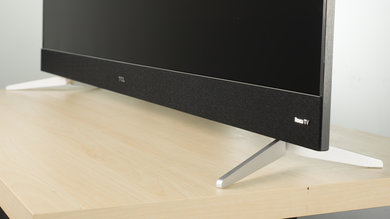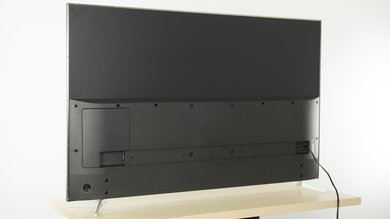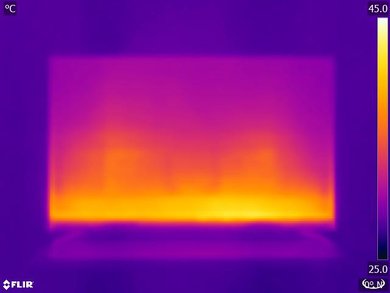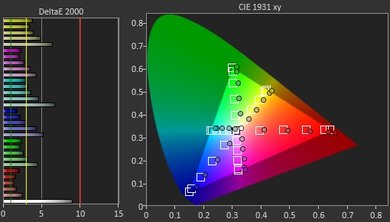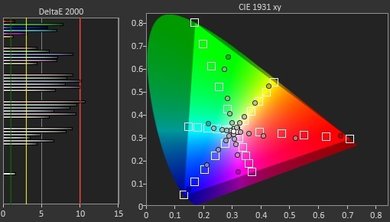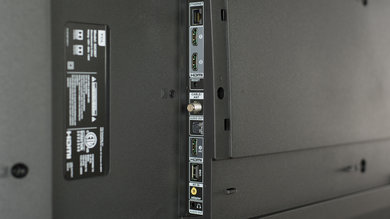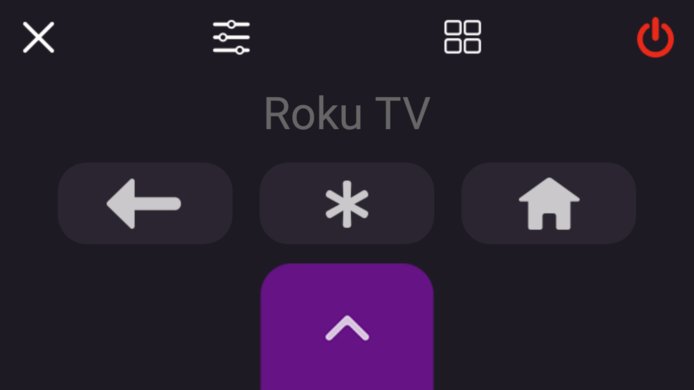Our Verdict
The TCL C807/C803 is decent for a mixed usage. Its contrast is good, and it features a wide color gamut for HDR. Unfortunately, though, its motion and uniformity of the blacks leave a lot to be desired.
- Sturdy, nicely finished design
- Roku smart platform is both simple and quick
- Could be brighter for HDR
- Poor black uniformity
- Picture quality degrades at an angle
Mediocre TV for movies in a dark room. The TCL C803/C807 does have a good contrast ratio, but its poor black uniformity and lack of local dimming cause letterboxes to look cloudy and distracting.
Decent TV for watching series or broadcast TV in a bright room. The TCL C Series' brightness is decent, and its Roku smart OS gives very easy access to content. Unfortunately, though, it's not great at handling reflections.
The TCL C Series' sports watching capabilities are average. It's relatively uniform, so green fields or ice rinks don't look dirty or blotchy, but its narrow viewing angle and mediocre motion handling reduce the viewing experience by a significant margin.
Better than average for playing video games. The TCL C807's impressively low input lag keeps inputs and gameplay responsive. Its motion blur could be a bit better though.
Mediocre TV for HDR. While the TCL C807/C803 has a wide color gamut and can reproduce smooth gradients, it cannot get bright enough to create a good HDR effect.
Decent HDR gaming capabilities. The TCL C807's input lag does not change depending on the type of input, so even HDR games are responsive. The wide color gamut helps make lush environments vibrant as well.
Passable PC Monitor. The C Series's low input lag and support for chroma 4:4:4 is good, but its slow pixel response time and narrow viewing angle make it less suitable for use as a PC monitor.
Changelog
- Updated Mar 12, 2018: Converted to Test Bench 1.2.
- Updated Mar 12, 2018: There is a problem with how the Xbox One, Xbox One S and Xbox One X detect the audio passthrough capabilities of TCL TVs; a workaround is detailed in the Additional Review Notes.
- Updated Aug 28, 2017: Review published.
- Updated Aug 26, 2017: Our testers have started testing this product.
Check Price
Differences Between Sizes And Variants
We tested the 55" (55C807). For the most part, we expect our review to be valid for the 65" (65C807) and 75" (75C807).
The 55C803 sold at Costco and a few other retailers is the same TV as the variant we've reviewed, but it comes packaged with a simpler remote which lacks voice control and a 3.5mm jack for private listening. These features can still be used with the virtual remote of the Roku app available on mobile devices.
If someone comes across a different type of panel or if their TCL C807 doesn't correspond to our review, let us know and we will update the review.
| Size | Model |
| 55" | 55C807 |
| 65" | 65C807 |
| 75" | 75C807 |
Popular TV Comparisons

The TCL C807 is a decent 4k LED TV, but it doesn't offer much beyond its nice design compared to competing TVs.
The TCL P Series/P607 2017 is much better than the TCL C Series/C807 2017. The P607 has a full-array local dimming feature that improves dark room performance and helps small highlights in some scenes in HDR to pop out better. The P607 also has a faster response time, so motion looks better with less blur trail.
The Sony X900F is much better than the TCL C Series/C807 2017. The X900F performs better in a dark room, as it has better black uniformity and a full-array local dimming feature. The Sony performs better in a bright room as it is brighter, and has better reflection handling. Motion looks smoother on the X900F thanks to the faster response time, and it can interpolate content up to 120Hz, further improving motion smoothness, although this effect may bother some people.
The TCL 6 Series 2018 is much better than the TCL C Series/C807 2017. The 6 Series is brighter and also has better dark room performance thanks to the full array local dimming feature and better black uniformity. Motion looks crisper with less blur, thanks to the faster response time, and the better black frame insertion feature can further improve motion clarity.
The Vizio P Series 2018 is much better than the TCL C Series/C807 2017. The Vizio P Series has better dark room performance thanks to the full array local dimming feature and much better black uniformity with less clouding. The P Series 2018 has better motion handling; it has a faster response time that produces less motion blur, and it can interpolate lower frame rate content up to 120Hz. The P Series 2018 also has a better black frame insertion feature that can further improve motion clarity.

We buy and test dozens of TVs yearly, taking an objective, data-driven approach to deliver results you can trust. Our testing process is complex, with hundreds of individual tests that take over a week to complete. Most of our tests are done with specially designed test patterns that mimic real content, but we also use the same sources you have at home to ensure our results match the real-world experience. We use two main tools for our testing: a Colorimetry Research CR-100 colorimeter and a CR-250 spectroradiometer.
Test Results
The rear of the TV is quite simple, and a 50/50 split between plastic and metal. It looks good, and all of the inputs are located at the side, providing easy access if placed close to a wall. There are also covers which hide the inputs.
The TV stays fairly cool overall, but the screen gets quite warm near the bottom where the edge-lit backlight LEDs are. Fortunately, the bottom of the TV never gets hot, because the sound bar below the screen isolates the bottom. The warmest parts of the TV that can be touched are the two sides of the TV near the bottom. However, these only get a little warm to the touch.
The TCL C807/C803 has an excellent native contrast ratio. With a contrast ratio of more than 5000:1, this means the TV can display dark scenes very well and with a lot of detail, and this will be even more obvious when the TV is set in a dark room.
There is no local dimming feature on the TCL C Series line of TVs. Video for reference only.
Very good SDR peak brightness. Because the TV lacks local dimming and CE dimming, the brightness stays constant no matter the content played, which is great. The TV is a little brighter overall than the rival Vizio M Series 2017, however, the TCL P607 is much brighter in nearly every test.
Mediocre HDR peak brightness. Even though the SDR and HDR peak brightnesses are essentially identical, HDR content demands higher brightness, as highlights are mastered to hit 1000-4000 cd/m², much higher than this TV is able to produce. The lack of local dimming really hurts here, as the TV isn't able to increase the backlight area behind highlights to make them brighter. Its rivals, the TCL P607 and Vizio M Series 2017, use their local dimming to reach much higher peak brightness.
The overall gray uniformity is average on the TCL 55C803/55C807. The 50% gray uniformity test picture does show some uniformity problems, especially near each corner, where the screen is darker. The top of the screen is also a bit darker and warmer than the bottom. In the middle of the screen, there is also a darker band with a strange dark patch. Unfortunately, dirty screen effect is visible when watching content like sports.
Looking at the 5% gray uniformity test picture, some uniformity issues can be noticed, especially the darker horizontal band near the center of the screen, but the more obvious issues (the brighter sides) are due to the narrow viewing angle effect on the camera.
Terrible viewing angle, even for a TV with a VA panel. Blacks turn gray and colors shift when the TV is viewed from even a small angle, while brightness decreases not long after. This TV is not a good fit for a room where people will often be sitting to the side of the TV and viewing it at an angle.
The black uniformity of the TCL C807 is disappointing. Most of the uniformity issues are due to the visible clouding near each corner of the screen. Note that here, the narrow viewing angle of this TV does affect the black uniformity a bit, as even when sitting right in front of the TV, the black level change on both sides of the TV, which in turn affect the black uniformity.
The TCL 55C803/55C807 is decent at handling reflections. It has a semi-gloss finish which diffuses reflections across the screen, reducing their intensity. It is fine for a dark or average room, but in a bright room, it may be an issue.
The TCL C807 accuracy is disappointing. Even when set to the 'Movie' picture, which is the most accurate of all the available picture mode, the overall accuracy is still pretty off target and most enthusiasts could notice it.
The white balance dE, even when set to the 'Warm' color is a bit high and on the warm side even though this color temperature setting is the most accurate. The higher IRE values (brighter) are less accurate, where the red is the most prominent. When set to other color temperature, the white balance dE was more than double of what is the dE of the 'Warm' color temperature.
The Color dE is a bit high too, and most of the color has a high dE, especially the white point, which is off target and seem to drag all the rest of the colors with it. Here once again the 'Warm' color was the most accurate, with the 'Normal' following it with a color dE of 6.38.
After calibration, the TCL C807 accuracy is outstanding and the mobile app helps a lot at obtaining this result since you can do all the calibration into the app, with a high level of precision. One benefit is that all this can be done off-screen and in real-time, so you don't need to go in and out of the menu to take readings, which make the whole process faster.
All the inaccuracies of the white balance were easily corrected and each IRE points were very responsive and did not affect neighboring value. As the result of this correction, the white balance dE is not only 0.12 and the gamma curve was flattened and the gamma is now tracker our 2.2 target almost spot on.
The color dE was also brought down to a negligible 0.42, which at this level, inaccuracy are not even perceivable by the human eye and all the issues that were present before calibration were easily fixed
You can see our recommended settings here.
Native 4k sources look great, however, when viewed from very close some pixel dimming artifacts are visible. This mostly affects PC use and is similar to other TCL TVs such as the P607 visible in a pixel photo here.
Very good wide color gamut. Looking at the Rec 2020 gamut, fully saturated red and blue get fairly close to their targets, but green falls quite short, as is common for modern TVs. However, the DCI P3 gamut shows how the TV starts sacrificing color accuracy for brightness when it's showing very bright colors. These two tests were done with 75% bright stimulus colors, which are very bright. The same tests done with 50% stimulus, shown here for P3 and here for 2020, show much better color accuracy, because the TV can easily reach this brightness.
The TV's HDR EOTF in the 'Dark' picture mode follows the target PQ curve very closely, up until it rolls off to meet its peak brightness. The EOTFs in Game and PC mode are nearly identical to that of the 'Dark' picture mode.
Decent color volume. While the volume is mostly limited by the TV's color gamut, its lack of local dimming prevents it from making colors very dark like the TCL P607 can, so it loses some volume at low brightness. The TV also struggles to show very bright DCI P3 colors, as it starts to sacrifice color saturation in order to make the colors brighter.
The 55C803/55C807 can display our gradient test image remarkably. Overall, the gradient is very smooth and 8-bit banding it not visible at all, which is great news, especially for HDR content. Banding in the colors is slightly noticeable in the very dark part of the image, but only to a couple of places in the dark gray and in the darker shade of color. Banding is not problematic at all when watching normal content though.
We don't expect VA panels to experience permanent image retention, as the VA panel in our long-term test appears immune.
The response time is ordinary, and a trail of blur can be seen following fast-moving objects. The panel response is quite similar to that of the TCL UP130 from 2016, and worse than the P607 and S405.
The TCL C803/C807 uses PWM at 120Hz to dim the backlight, starting at 28/100 backlight setting. Lowering the setting from 100/100 to 29/100 reduces backlight amplitude, and lowering it from 28/100 to 0/100 shortens the PWM duty cycle while amplitude remains constant. The use of PWM at lower backlight settings results in duplications following fast-moving objects.
Like with other TCL TVs, there is no option to reduce the flicker frequency to 60 Hz, although its 120 Hz PWM does help somewhat to clear up fast-paced content.
The TCL C803/C807 is unable to produce any motion interpolation, so viewers who enjoy the smoother motion of the soap opera effect may be disappointed.
This TCL TV can display content with very little stutter, which is great. 60 fps content appears completely smooth as the pixel response time means that some parts of the image are always in motion. For 24 fps content such as movies, the image is also relatively smooth, as it only remains static for ~16ms between ~41ms frames.
The TCL C series can play 24p movies from 24p sources like DVDs and Blu-rays without judder and no specific option needs to be turned on. For 24p movies playing from 60p/60i sources like cable or satellite boxes, the TV can't display them correctly without judder and there is not any option in the TV picture setting to remove judder from 24p movies on those sources, unfortunately.
The TCL C807/C803 doesn't have any variable refresh rate implementation, which is normal for 2017 TVs.
Amazing low input lag, which will please nearly any gamer. All picture modes have the same input lag when the 'Game mode' setting is 'On'. 4:4:4 color is only shown properly when the input's icon is set to 'Computer' (or the TV detects a PC input). This input lag is nearly identical to that of the TCL P607 and S405, and significantly better than the Vizio M Series 2017.
Most common resolutions are supported, except for 120 Hz because the TV has a 60 Hz panel. 4k @ 60 Hz @ 4:4:4 or 4:2:2 color is only supported when the input has been set to 'HDMI 2.0'. 4:4:4 color is only shown properly when the input's icon has been set to 'Computer'. The TV also detects when the signal is coming from a PC, and invisibly forces the 'Computer' mode without changing the icon, meaning that 4:4:4 color is shown properly and the sharpening setting has no effect.
The C series has two 3.5mm analog audio jacks. One is situated out of the side of the TV and the other one is on the left side of the remote. This wireless solution is very practical for those who want to listen to the TV privately.
Update 01/24/2018: There is a problem with how the Xbox One, Xbox One S and Xbox One X detect the audio passthrough capabilities of TCL TVs; a workaround is detailed in the Additional Review Notes.
To enable Dolby Digital passthrough, 'S/PDIF and ARC' must be manually set to 'Dolby D, DTS'. Strangely vanilla Dolby Digital doesn't work when 'S/PDIF and ARC' is set to 'Dolby D+, DTS'.
Average frequency response. The TCL C807 follows our target quite well at most volumes, but its limited bass extension deteriorates the experience quite a lot causing it to sound a bit tinny. Unfortunately, dynamic range compression is present at higher volumes as well.
Decent distortion performance. The C807/C803 doesn't produce a lot of distortion at an average volume, but it is audible at higher levels. Aliasing is also present even as low as 80 dB.
The Roku TV interface is lightning fast and very smooth, with almost no lag or frame drops to be seen. It has a column-based layout which is fast and easy to navigate. However, almost all tasks require you to pass through the home menu first, which can slow down some interactions. When content is playing, there is a quick menu containing picture and audio settings, which often saves a trip through the home menu when changing basic things.
The TV has no ads in its main interface. However, the home menu has a large box for suggested content, which can be a little annoying.
The Roku TV platform offers a large variety of apps, including almost all the popular ones like Netflix, YouTube and Amazon Video, though some other platforms like Android TV have more apps available. Apps run smoothly with little lag or frame drops.
The C807's remote is nearly identical to that of its sibling, the P607. The remote has a headphone jack for playing the TV's audio, which works quite well, even for HDMI input. It is a small remote, but it's surprisingly thick and heavy for its size because of the larger batteries needed to power the headphone jack. The buttons are a little mushy and don't offer very good feedback. There also aren't many buttons, which isn't a problem when browsing the interface and apps but can slow down interaction a bit when browsing over-the-air channels due to the lack of number buttons.
The Roku app is one of the best, offering many useful features like text entry and streaming files off the device running the app. The app can also play the TV's sound through the device running the app, though this doesn't work for realtime inputs like HDMI or antenna. The text entry, unfortunately, doesn't work in some apps like YouTube, and the only TV settings the app can change are display calibration settings, which are only found in the app and not in the TV's interface itself.


